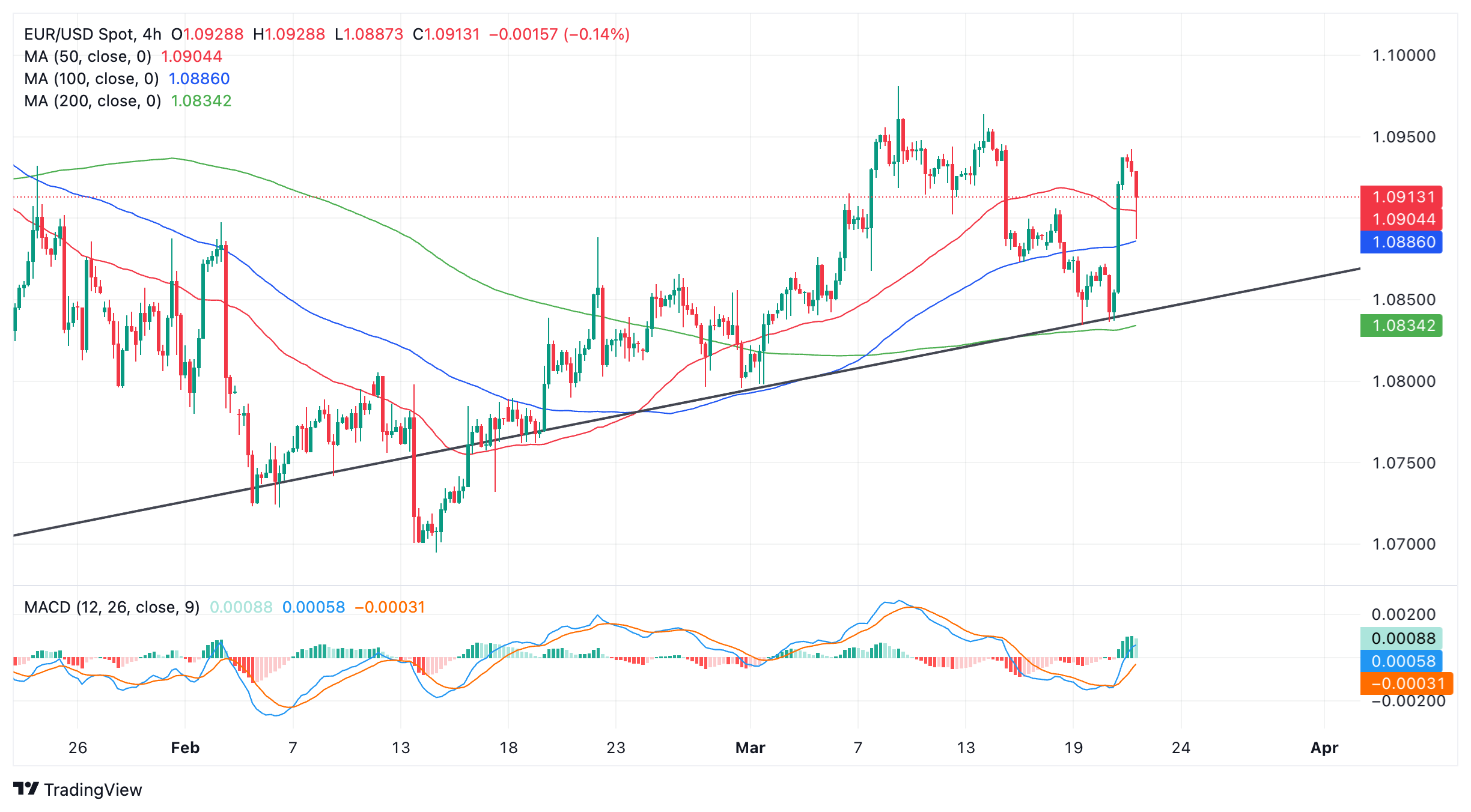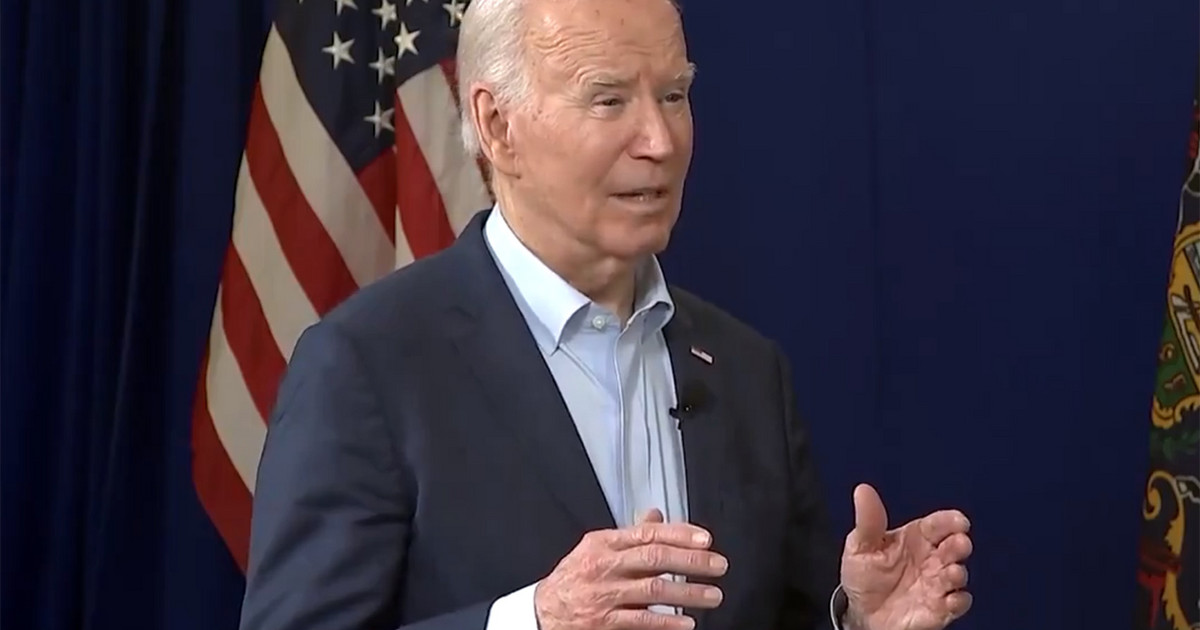- The EUR/USD pair falls after the publication of German and Eurozone PMI data, which show a contraction in the manufacturing sector.
- This move halted gains made after the Federal Reserve maintained a dovish stance, weakening the US dollar.
- The Fed still expects to make three 0.25% interest rate cuts in 2024, the same as in December.
The EUR/USD pair retreated half a percentage point on Thursday, settling back at 1.0800, following the release of US and Eurozone PMI data, as well as US Initial Jobless Claims. .US and the manufacturing sector of the Philadelphia Fed. Overall, the US data was better than expected.
The move pared gains made following the Federal Reserve's decision to keep interest rates at their current levels and maintain expectations that it will cut interest rates three times in 2024.
The decline in EUR/USD increases after the publication of US data
The EUR/USD pair suffered fresh losses after the release of US March PMI data, initial jobless claims and the Philadelphia Fed Manufacturing Index, which supported the Dollar and led the pair to approach the lows. of the day in the area of 0.6580.
The US S&P Global Composite PMI stood at 52.2, above the 50 level that distinguishes expansion from contraction. The US manufacturing PMI stood at 52.5, beating estimates and previous numbers. The services PMI, however, came in below expectations and previous results, at 51.7 in March.
The Philadelphia Fed manufacturing survey came in at 3.2, above estimates, and initial jobless claims at 210,000 came in below forecasts at 215,000.
EUR/USD turns lower after the weight of the manufacturing PMI
EUR/USD trimmed its Fed gains after Eurozone manufacturing PMI data painted a bleak picture of growth in the Eurozone. Although the composite PMI rose to 49.9, beating estimates of 49.7 and the previous February reading of 49.2, an unexpected decline in the manufacturing sector marred the outlook.
The March HCOB Manufacturing PMI fell to 45.7, a larger contraction than expected (below 50). Economists had estimated a more buoyant rise to 47.0 from 46.5 previously.
The euro zone HCOB services PMI rose to 51.1 in March, beating estimates of 50.5 from the previous 50.2, according to data from S&P Global.
For its part, European economic powerhouse Germany showed a similar trend, with the German HCOB Manufacturing PMI falling to 41.6, below estimates of 43.1 and 42.5 in February. However, there were also unexpected gains in both the services component and the composite figure.
According to FXStreet analyst Dhwani Mehta, the euro's decline following the data was due to a “deeper contraction in the manufacturing sector in both Germany and the EU.”
The Fed maintains the status quo
At its policy meeting on Wednesday, the Federal Reserve left the federal funds rate unchanged at 5.25%-5.50%, as expected. In the accompanying forecast document, the Summary of Economic Projections (SEP), it continued to forecast a drop in rates to an average target of 4.6% in 2024, as it did in December.
This is equivalent to expecting around three rate cuts of 25 basis points (0.25%) this year, although some market participants had speculated that the number of cuts would be reduced to two due to stronger inflation of what was planned.
However, it forecast fewer rate cuts in 2025, with the federal funds rate falling to a median of just 3.9%, instead of 3.6% in December's SEP.
The Federal Reserve revised its GDP forecasts substantially upward, to 2.1% for 2024, from 1.4% in December, which many consider indicative of a “soft landing.”
The central bank's preferred inflation gauge, the core personal consumption expenditure (PCE) price index, was revised upward to 2.6% by 2024, from 2.4% in December.
In his post-meeting press conference, Federal Reserve Chairman Jerome Powell sought to downplay the latest batch of rising inflation readings, saying that just two months of data were not enough to dissuade the Fed from his path.
The general interpretation was of a “moderate hold”, causing the US Dollar to sell off from overbought territory. The EUR/USD pair, which measures the purchasing power of one Euro (EUR) in US dollars (USD), rose again into familiar territory.
Technical analysis: EUR/USD returns to 1.0900
The EUR/USD pair reversed on a dime around the 200-day SMA level at 1.0830 and rose after the Fed meeting. On Thursday, however, it pared gains after weak Eurozone manufacturing data.
It is now trading below 1.0900 and appears to be moving in a range, with no real trend one way or the other.

Euro vs. US Dollar: 4-hour chart
However, Wednesday's bearish reversal still shows momentum and if the price moves higher, it will likely find resistance at the March 13 highs at 1.0964. If it exceeds them, the highs for the month of March 8 would be at 1.0981. If it exceeds them, the outlook will once again be bullish.
Source: Fx Street
I am Joshua Winder, a senior-level journalist and editor at World Stock Market. I specialize in covering news related to the stock market and economic trends. With more than 8 years of experience in this field, I have become an expert in financial reporting.






